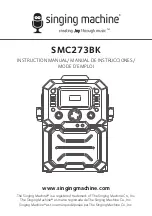
9
GB
Safety information
Safety information
If electrical contact voltage occurs, immediately
switch the equipment off and have it inspected
by an electrically skilled person.
Always ensure good electrical contacts on the
welding current end.
Always wear insulating gloves on both hands
whilst welding. These will protect from electric
shock (no-load voltage of the welding current),
from hazardous rays (heat and UV rays) and
glowing metal and weld splashes.
Wear solid, insulating shoes. The shoes should
also insulate when exposed to moisture. Low
shoes are not suitable, as glowing metal drops
falling could cause burns.
Wear suitable protective clothing, no synthetic
garments.
Do not look into the arc with unprotected eyes,
only use a welding shield with approved pro-
tective glass per DIN. In addition to light- and
heat rays which could result in blinding or burns,
the arc also emits UV rays. Without adequate
protection, this invisible ultraviolet radiation
causes very painful conjunctivitis which is only
noticed a few hours later. UV rays further cause
burns similar to a sunburn in unprotected areas
of the body.
Persons near the arc or assistants must also be
informed of the risks and outfitted with the nec-
essary protection. If necessary, set up protective
panels.
Ensure an adequate supply of fresh air whilst
welding, particularly in small spaces, as it pro-
duces smoke and harmful gasses.
Do not weld containers in which gasses, fuels,
mineral oils, etc. were stored - even if emptied
a long time ago - as residue poses an explosion
hazard.
Special regulations apply in rooms posing
fire- and explosion hazards.
Welded joints exposed to great strain and
needing to meet certain safety requirements must
be made by specially trained and certified weld-
ers. Examples are pressure vessels, running rails,
tow couplings, etc.
ATTENTION!
Always connect the earth termi-
nal as close as possible to the point of weld to
provide the shortest possible path for the
welding current from the electrode to the earth
terminal. Never connect the earth terminal to
the housing of the welding equipment!
Never connect the earth terminal to earthed
parts far away from the work piece, e.g. a
water pipe in another corner of the room. This
could otherwise damage the protective bond-
ing system of the room you are welding.
Do not use the welding equipment in the rain.
Do not use the welding equipment in a moist
environment.
Only place the welding equipment in a level
location.
The output is rated at an ambient temperature
of 20 °C. The welding time may be reduced in
higher temperatures.
Danger of electric shock:
Electric shock from a welding electrode
can be fatal. Do not weld in rain or snow.
Wear dry insulating gloves. Do not touch
the electrode with bare hands. Do not wear wet or
damaged gloves. Protect yourself from electric shock
by insulating from the work piece. Do not open the
equipment housing.
Danger due to welding smoke:
Inhaling welding smoke can jeopardize your health.
Keep your head out of the smoke. Use facilities in
open areas. Use ventilation to remove smoke.
Danger due to welding sparks:
Welding sparks can cause an explosion or fire.
Keep flammables away from the welding area. Do
not weld next to flammables. Welding sparks can
cause a fire. Keep a fire extinguisher nearby and
an observer ready to use it. Do not weld on top of
drums or any closed containers.
Danger due to arc rays:
Arc rays can damage the eyes and injure the skin.
Wear a hat and safety goggles. Wear hearing pro-
tection and a closed, high shirt collar. Wear welding
helmets and proper filter sizes. Wear full personal
protection.
270751_Inverter Schweissgeraet PISG 80 A1_content_CZ.indd 9
27.01.16 15:00
Содержание PISG 80 A1
Страница 4: ...270751_Inverter Schweissgeraet PISG 80 A1_cover_CZ indd 6 27 01 16 15 00...
Страница 36: ...Wiring diagram Schaltplan 270751_Inverter Schweissgeraet PISG 80 A1_cover_CZ indd 7 27 01 16 15 00...
Страница 37: ...270751_Inverter Schweissgeraet PISG 80 A1_cover_CZ indd 8 27 01 16 15 00...










































